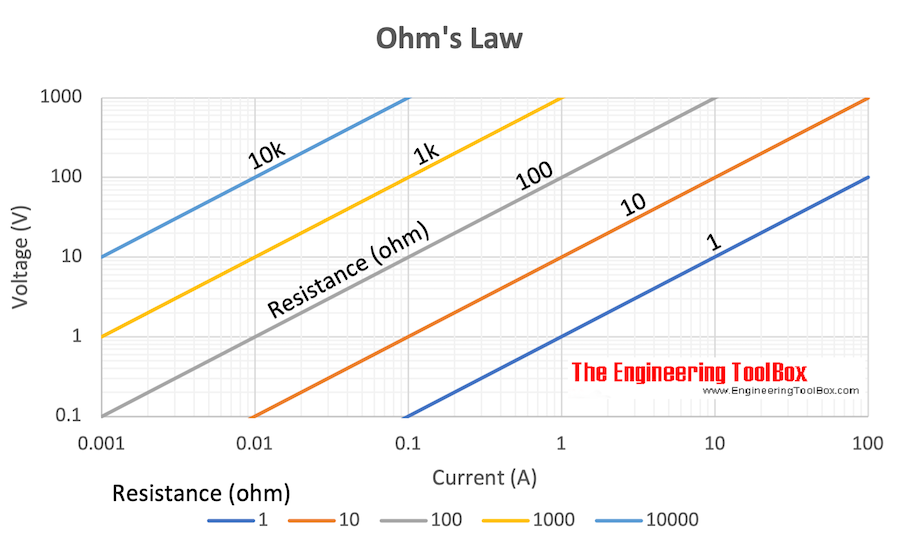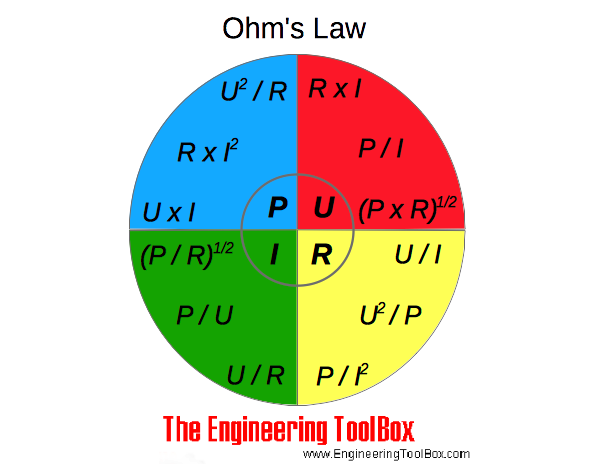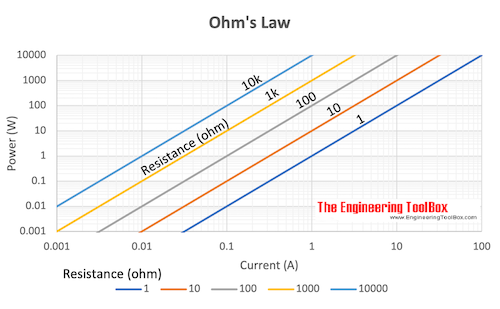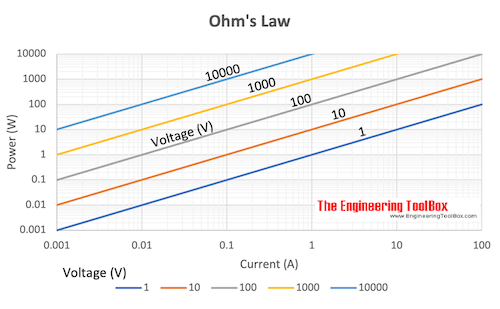Electrical Formulas
Commonly used electrical formulas like Ohms Law and more.
Common electrical units used in formulas and equations are:
- Volt - unit of electrical potential or motive force - potential is required to send one ampere of current through one ohm of resistance
- Ohm - unit of resistance - one ohm is the resistance offered to the passage of one ampere when impelled by one volt
- Ampere - units of current - one ampere is the current which one volt can send through a resistance of one ohm
- Watt - unit of electrical energy or power - one watt is the product of one ampere and one volt - one ampere of current flowing under the force of one volt gives one watt of energy
- Volt Ampere - product of volts and amperes as shown by a voltmeter and ammeter - in direct current systems the volt ampere is the same as watts or the energy delivered - in alternating current systems - the volts and amperes may or may not be 100% synchronous - when synchronous the volt amperes equals the watts on a wattmeter - when not synchronous volt amperes exceed watts - reactive power
- kiloVolt Ampere - one kilovolt ampere - kVA - is equal to 1000 volt amperes
- Power Factor - ratio of watts to volt amperes
Ohm's Law Calculator
Add values for two parameters and the two others will be calculated. Delete the input for the values you want to calculate.
Electrical Potential - Ohm's Law
Ohm's law can be expressed as:
U = R I (1a)
U = P / I (1b)
U = (P R)1/2 (1c)
Electric Current - Ohm's Law
I = U / R (2a)
I = P / U (2b)
I = (P / R)1/2 (2c)
Electric Resistance - Ohm's Law
R = U / I (3a)
R = U2/ P (3b)
R = P / I2 (3c)
Example - Ohm's law
A 12 volt battery supplies power to a resistance of 18 ohms.
I = (12 V) / (18 Ω)
= 0.67 (A)
Electric Power
P = U I (4a)
P = R I2 (4b)
P = U2/ R (4c)
where
P = power (watts, W, J/s)
U = voltage (volts, V)
I = current (amperes, A)
R = resistance (ohms, Ω)
Electric Energy
Electric energy is power multiplied with time:
W = P t (5)
where
W = energy (Ws, J)
t = time (s)
Alternative - power can be expressed
P = W / t (5b)
Power is consumption of energy by consumption of time.
Example - Energy lost in a Resistor
A 12 V battery is connected in series with a resistance of 50 ohm. The power consumed in the resistor can be calculated as
P = (12 V)2 / (50 ohm)
= 2.9 W
The current through the resistor can be calculated as
I = (2.9 W) / (12 V)
= 0.24 A
The energy dissipated in 60 seconds can be calculated
W = (2.9 W) (60 s)
= 174 Ws, J
= 0.174 kWs
= 4.8 10-5 kWh
Example - Electric Stove
An electric stove consumes 5 MJ of energy from a 230 V power supply when turned on in 60 minutes.
The power rating - energy per unit time - of the stove can be calculated as
P = (5 MJ) (106 J/MJ) / ((60 min) (60 s/min))
= 1389 W
= 1.39 kW
The current can be calculated
I = (1389 W) / (230 V)
= 6 ampere
Electrical Motors
Electrical Motor Efficiency
μ = 746 Php / Pinput_w (6)
where
μ = efficiency
Php = output horsepower (hp)
Pinput_w = input electrical power (watts)
or alternatively
μ = 746 Php / (1.732 V I PF) (6b)
Electrical Motor - Power
P3-phase = (U I PF 1.732) / 1,000 (7)
where
P3-phase = electrical power 3-phase motor (kW)
Electrical Motor - Amps
I3-phase = (746 Php) / (1.732 VμPF) (8)
where
I3-phase = electrical current 3-phase motor (amps)
Related Topics
-
Electrical
Electrical engineering with units, amps and electrical wiring. Wire gauges, electrical formulas, motors and more.
Related Documents
-
12 Volt - Maximum Wire Length vs. Current
Maximum length of copper wire with 2% voltage drop. -
Aluminum Conductor Characteristics
Characteristics of all-aluminum conductors (AAC). -
Copper and Aluminum Wire - Max Amps vs. Gauge
Maximum current in copper and aluminum wire. -
Copper Wire - Electrical Resistance vs. Gauge
Gauge, weight, circular mils and electrical resistance in copper wire. -
Electric Circuit Diagram - Drawing Template
Online shareable electric circuit diagram. -
Electrical Equipment - Power Consumption
Typical power consumption and running time for common electrical equipment. -
Electrical Units
Definition of common electrical units - like Ampere, Volt, Ohm, Siemens. -
Electrical Vehicle Charging - Power vs. Voltage and Amps
EV Charging - AC vs. DC, single phase vs. three phase and power vs. voltage and amps. -
Electrical Voltage and Frequency Standards by Country
Typical voltages and frequencies used for domestic appliances in different countries. -
Electromotive Force - e.m.f
Change in electrical potential between two points. -
Electrotechnical Abbreviations
Abbreviations according the International Electrotechnical Commission (IEC). -
Lead-Acid Batteries
Specific gravity and charge of lead acid batteries - temperature and efficiency. -
Ohm's Law
The relation between voltage, current and electrical resistance. -
Relative vs. Absolute Voltage
Electric circuits and voltage at any point. -
Resistance vs. Conductance
The reciprocal of electrical resistance is conductance. -
Resistivity and Conductivity - Temperature Coefficients Common Materials
Resistivity, conductivity and temperature coefficients for common materials like silver, gold, platinum, iron and more.. -
Resistors - Color Codes Calculator
Color codes for fixed resistors - values and tolerances - online calculator. -
Single and Three Phase AC - Electric Current vs. Power
Convert between single phase (120, 240 and 480 Voltage) and three phase (240 and 480 Voltage). -
Single Phase Power Equations
Power equations for single phased electrical systems. -
Three-Phase Power - Equations
Electrical 3-phase equations. -
Voltage Sources vs. Current Sources
Voltage and Current Sources








